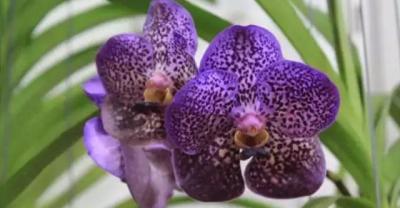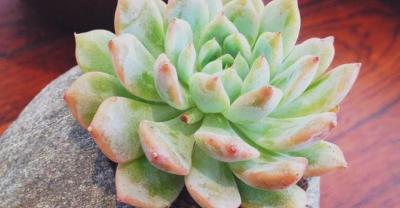The cultivation method of Wandai orchid: how to plant and maintain the orchid? What is the implication of the flower language of Wandailan?
Vanda orchid not only looks dignified and beautiful, but also tenacious vitality, in harsh conditions, can still reveal fragrance, so was selected as the national flower of Singapore. Below, Xiaobian will introduce you to the breeding method of Vanda orchid and the flower language of Vanda orchid for your reference.

Vandai orchid was originally a Sanskrit word for Indian, meaning orchid hanging on tree. She is a very special orchid. Without soil, without any plant material, it can grow very vigorously. It is an aerial orchid that absorbs oxygen from the air only by its aerial roots. In the wild state is attached to the trunk or stone growth, which seems to go beyond our understanding of plants, people feel magical.
Culture method of Vanda orchid
Vanda orchids require more fertilizer than other orchids, so dilute fertilizer can be applied every 7 to 10 days during vigorous growth. The best fertilizer is nitrogen, phosphorus and potassium in a ratio of 10:10:5. Because the root of Vanda orchid belongs to aerial root, any medium with good drainage can be applied, such as snake sawdust, broken brick, charcoal, coarse gravel sand, etc., whether used alone or in combination, it is a good basin soil. In addition to the medium, the pot for planting Vanda orchids must also be very careful. Among the pots made of various materials, wooden battens and pottery pots are preferred, and several holes are perforated in the pots, which is more conducive to good drainage and air circulation. In addition to wooden battens and pottery pots, Vanda orchids can also grow well on snake boards or tree trunks. Vanda orchids should not be changed frequently, unless they are infested by pests and diseases, otherwise they can only be changed once every at least 3 years.
Spring Vanda is about to enter the vigorous growth period, is a good time to change pots. The root system of Vanda orchid, which has grown for many years, will be tightly attached to the inner wall of the pot. Therefore, if it is planted in a pottery pot, it is best to break the pot and change the pot to avoid damaging the root system when taking out the plant.

Finally, no matter what kind of cultivation method is used, remember that the pot soil must be drained and ventilated very well.
Vanda can be propagated in tissue culture or high bud propagation. However, the former is not suitable for home propagation because it requires more professional skills. At the end of autumn, Vanda orchid will grow high buds in the axils of leaves. When the high buds grow to 5~7.5cm, use sharp and sterilized knives to cut off the high buds from the mother plant and plant them in pots filled with snake sawdust. They can be transplanted to larger pots. Remember to apply medicine to the incision to prevent infection.
In addition, when the plants cultivated for many years grow to more than 1m, you can cut off the terminal buds about 30~46cm long, apply medicine to disinfect the cuts on both sides, and then plant them in pots and keep them moist. Pest control Tough leaves are the main reason why Vanda orchids are less susceptible to pests. Common pests, except snails and slugs, are less common on robust Vanda orchids. But when water stays in the leaves for too long, or is infected by viruses, dark spots or patches often appear and decay gradually. If the condition is mild, the affected part can be excised. In case the area of decay is too wide, the whole orchid must be discarded so as not to infect other orchids.

Flower language of Vanda orchid
Orchid flower language: personality, excellence, eternal generations.
Vanda Orchid looks elegant and dignified, outstanding, but also shows humility, symbolizing the temperament of the people of Singapore. Bandai orchid has a beautiful lip and five respect pieces, lip four split, symbolizing the equality of the four ethnic groups of Singapore and the four languages of Malay, English, Chinese and Tamil.
Vanda flowers in the middle of the evil column, male and female body, symbolizing the root of happiness. The flowers are supported by opposite lobes below, symbolizing harmony, sharing weal and woe, sharing honor and disgrace. Vanda orchid flowers have a pouch-shaped angle behind the lip, there is sweet juice, a symbol of wealth convergence gathering place.
Take off the pollen cover on the Wandai Orchid Love Column, and there are two flower blocks inside, like two "golden eyes", symbolizing foresight. Vanda orchid stem upward climbing, a symbol of upward development, prosperity. Its flowers wither and bloom again, symbolizing the lifeblood of Singapore's nation, which has a long history and endless confidence and hope.

Key Points of Vandai Orchid Conservation
Evergreen epiphytic perennial herb. The flowers are large and colorful, and there are many varieties. At present, all of them are excellent hybrid varieties. Usually planted in perforated pots or wooden boxes, hanging in greenhouses; with charcoal, broken bricks, etc. as substrate. The root is required to be very breathable and likes high temperature and humidity; the normal growth temperature is above 20℃. It likes sufficient sunshine and shade 30%~50% in greenhouse cultivation in the north. Maintain high air humidity. Spraying fertilizer to foliage every 1~2 weeks in growth period. Spray water on the plants once or twice a day.
Propagation: plant division, aseptic seeding and tissue culture.
Light: like strong light, not tolerant of shade (sufficient light).
Moisture: Growing in moist soil.
Temperature: not cold, freezing below 0℃ will occur.
Humidity: humidity, relative humidity is higher than 60%, generally 70%~90%.
- Prev

Flower cultivation skills: culture skills of sea anemone turnip
The peculiar-sounding plant of the sea anemone is the leopard skin flower of the family Asclepiadaceae, also known as Cape Raikare, which is native to tropical Africa. It's a kind of.
- Next

The implication of fengshui and culture skills of money tree
Guide to the money Tree, also known as American Railway Taro and Jinsong. Shoot without main stem, adventitious buds germinate from tubers to form large compound leaves, leaflets fleshy with short petiolule, firm.
Related
- On the eggshell is a badge full of pride. British Poultry Egg Market and Consumer observation
- British study: 72% of Britons are willing to buy native eggs raised by insects
- Guidelines for friendly egg production revised the increase of space in chicken sheds can not be forced to change feathers and lay eggs.
- Risk of delay in customs clearance Australia suspends lobster exports to China
- Pig semen-the Vector of virus Transmission (4)
- Pig semen-the Vector of virus Transmission (3)
- Five common causes of difficult control of classical swine fever in clinic and their countermeasures
- Foot-and-mouth disease is the most effective way to prevent it!
- PED is the number one killer of piglets and has to be guarded against in autumn and winter.
- What is "yellow fat pig"? Have you ever heard the pig collector talk about "yellow fat pig"?

